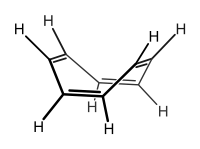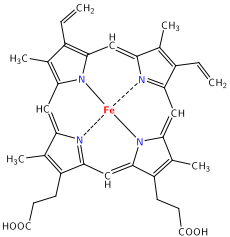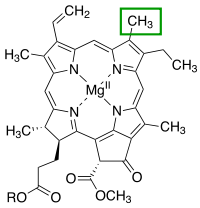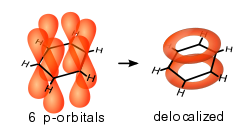- Conjugated system
-
In chemistry, a conjugated system is a system of connected p-orbitals with delocalized electrons in compounds with alternating single and multiple bonds, which in general may lower the overall energy of the molecule and increase stability. Lone pairs, radicals or carbenium ions may be part of the system. The compound may be cyclic, acyclic, linear or mixed.
Conjugation is the overlap of one p-orbital with another across an intervening sigma bond (in larger atoms d-orbitals can be involved).[1]
A conjugated system has a region of overlapping p-orbitals, bridging the interjacent single bonds. They allow a delocalization of pi electrons across all the adjacent aligned p-orbitals.[2] The pi electrons do not belong to a single bond or atom, but rather to a group of atoms.
The largest conjugated systems are found in graphite, conductive polymers, and carbon nanotubes.
Contents
Mechanism
 Conjugation with different kinds of p-orbital donating groups
Conjugation with different kinds of p-orbital donating groups
Conjugation is possible by means of alternating single and double bonds, but also in other ways. As long as each contiguous atom in a chain has available a p-orbital, the system can be considered conjugated. For example, furan (see picture) is a five-membered ring with two alternating double bonds and an oxygen in position 1. Oxygen has two lone pairs, one of which occupies a p-orbital on that position, thereby maintaining the conjugation of that five-membered ring. The presence of a nitrogen in the ring or groups α to the ring like a carbonyl group (C=O), an imine group (C=N), a vinyl group (C=C), or an anion will also suffice as a source of pi orbitals to maintain conjugation.
Conjugated cyclic compounds
 Cyclooctatetraene. Adjacent double bonds are not coplanar.
Cyclooctatetraene. Adjacent double bonds are not coplanar.
Cyclic compounds can be partly or completely conjugated. Annulenes, completely conjugated monocyclic hydrocarbons, may be aromatic, non-aromatic or anti-aromatic.
Aromatic compounds
Conjugated, planar, cyclic compounds that follow Hückel's rule are aromatic and exhibit an unusual stability. The classic example benzene has a system of all together 6 electrons above and below the flat planar ring.
Non-aromatic compounds
Not all compounds with alternating double and single bonds are aromatic. Cyclooctatetraene, for example, possesses alternating single and double bonds. The molecule typically adopts a "tub" conformation. Because the p-orbitals of the molecule do not align themselves well in this non-planar molecule, the electrons are not as easily shared between the carbon atoms. The molecule can be still considered conjugated, but is neither aromatic, nor antiaromatic (because it is not planar).
Conjugated systems in pigments
Conjugated systems have unique properties that give rise to strong colors. Many pigments make use of conjugated electron systems, such as the long conjugated hydrocarbon chain in beta-carotene, resulting in a strong orange color. When an electron in the system absorbs a photon of light of the right wavelength, it can be promoted to a higher energy level. (See particle in a box). Most of these electronic transitions are from one conjugated π-system molecular orbital (MO) with a even kind of symmetry to an other conjugated π-system MO with an odd kind of symmetry (π to π*), but electrons from other states can also be promoted to a π-system MO (n to π*) as often happens in charge-transfer complexes. Often an HOMO to LUMO transition is made by an electron if it is allowed by the selection rules for electromagnetic transitions. Conjugated systems of fewer than eight conjugated double bonds absorb only in the ultraviolet region and are colorless to the human eye. With every double bond added, the system absorbs photons of longer wavelength (and lower energy), and the compound ranges from yellow to red in color. Compounds that are blue or green typically do not rely on conjugated double bonds alone.
This absorption of light in the ultraviolet to visible spectrum can be quantified using UV/VIS spectroscopy, and forms the basis for the entire field of photochemistry.
Conjugated systems that are widely used for synthetic pigments and dyes are diazo and azo compounds and phthalocyanine compounds.
Phthalocyanine compounds
Conjugated systems not only have low energy excitations in the visible spectral region but they also accept or donate electrons easily. Phthalocyanines, which, like Phthalo Blue and Phthalo Green, often contain a transition metal ion, exchange an electron with the complexed transition metal ion that easily changes its oxidation state. Pigments and dyes like these are charge-transfer complexes.
Porphyrins and similar compounds
Porphyrins have conjugated molecular ring systems (macrocycles) that appear in many enzymes of biological systems. As a ligand, porphyrin forms numerous complexes with metallic ions like iron in hemoglobin that colors blood red. Hemoglobin transports oxygen to the cells of our bodies. Porphyrin-metal complexes often have strong colors. A similar molecular structural ring unit called chlorin is similarly complexed with magnesium instead of iron when forming part of the most common forms of chlorophyll molecules, giving them a green color. Another similar macrocycle unit is corrin, which complexes with cobalt when forming part of cobalamin molecules, constituting Vitamin B12, which is intensely red. The corrin unit has six conjugated double bonds but is not conjugated all the way around its macrocycle ring.



Heme group of hemoglobin The chlorin section of the chlorophyll a molecule. The green box shows a group that varies between chlorophyll types. Cobalamin structure includes a corrin macrocycle. Chromophores
Conjugated systems form the basis of chromophores, which are light-absorbing parts of a molecule that can cause a compound to be colored. Such chromophores are often present in various organic compounds and sometimes present in polymers that are colored or glow in the dark. Chromophores often consist of a series of conjugated bonds and/or ring systems, commonly aromatic, which can include C-C, C=C, C=O, or N=N bonds.
 Chemical structure of beta-carotene. The eleven conjugated double bonds that form the chromophore of the molecule are highlighted in red.
Chemical structure of beta-carotene. The eleven conjugated double bonds that form the chromophore of the molecule are highlighted in red.
Conjugated chromophores are found in many organic compounds including azo dyes (also artificial food additives), compounds in fruits and vegetables (lycopene and anthocyanidins), photoreceptors of the eye, and some pharmaceutical compounds such as the following:
 This polyene antimycotic called Amphotericin B has a conjugated system with seven double bonds acting as a chromophore that absorbs strongly in the ultraviolet-visible spectrum, giving it a yellow color.
This polyene antimycotic called Amphotericin B has a conjugated system with seven double bonds acting as a chromophore that absorbs strongly in the ultraviolet-visible spectrum, giving it a yellow color.
Common examples
See also
References
- ^ IUPAC Gold Book conjugated system (conjugation)
- ^ March Jerry; (1985). Advanced Organic Chemistry reactions, mechanisms and structure (3rd ed.). New York: John Wiley & Sons, inc. ISBN 0-471-85472-7
Chemical bonds Intramolecular
("strong")Sigma bond · Pi bond · Delta bond
Double bond · Triple bond · Quadruple bond · Quintuple bond · Sextuple bond
3c–2e · 3c–4e · 4c–2e
Agostic bond · Bent bond · Dipolar bond · Pi backbond
Conjugation · Hyperconjugation · Aromaticity · Hapticity · AntibondingCation–pi bond · Salt bondIntermolecular
("weak")Other noncovalentNote: the weakest strong bonds are not necessarily stronger than the strongest weak bonds Categories:- Chemical bonding
- Physical organic chemistry
Wikimedia Foundation. 2010.




